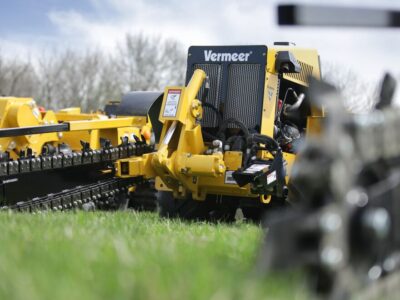Vermeer offers a wide range of utility installation equipment. With so many options, it can be hard to determine whether a trencher or horizontal directional drill (HDD) is right for your jobsite. On top of that, there’s also deciding the right size of machine for your business. Here are a few things to keep in mind.
Location
The location and surroundings of your jobsite play a big factor in selecting the right equipment.
Urban environments are typically well-developed areas, creating numerous obstacles like roads, driveways and buildings. These are all things contractors must navigate around for underground utility installation and makes trenchless installation an appealing method.
“Using trenchless installation methods, like horizontal directional drilling, auger boring and piercing tools, tends to be more efficient than cutting through hard surfaces and then repairing them,” said Ed Savage, Vermeer product manager.
“Rural areas, however, have fewer road intersections and other obstacles to account for,” said Savage. “Trenching or using a vibratory plow in these areas is typically faster than using HDD alone.”
Trenching is also a preferred method when installing utilities in greenfield development projects. With preexisting underground utilities being limited, there are not many obstacles to navigate around.
Utility bundle size and installation depth
When selecting the right utility installation equipment, it is also important to consider the utility bundle size and the installation depth. This also helps determine what size machine is best for your purposes.
“If a contractor is installing small-diameter electrical or fiber lines at a shallow depth in soft soil conditions, a vibratory plow is likely their best option,” said Savage.
However, when installing large product in hard rock, you’ll need a high-power machine to get the job done.
“In rock and when installing large-diameter products at depths greater than 5 ft (1.5 m), contractors may consider using a higher horsepower trencher with a larger boom and chain configuration that allows them to cut a trench the required width,” said Savage.
Equipment availability
Another consideration when deciding between HDD and trenching is equipment availability.
“Unlike directional drills, trenchers are typically available at rental stores,” said Savage. “Renting can be an attractive solution if the contractor only has a minimal amount of product to install.”
Both trenchers and HDD can get the job done when it comes to underground utility installation. To learn more about the differences between HDD and trenching and rental equipment availability near you, contact your local Vermeer dealer.
Vermeer Corporation reserves the right to make changes in product engineering, design and specifications; add improvements; or discontinue manufacturing or distribution at any time without notice or obligation. Equipment shown is for illustrative purposes only and may display optional accessories or components specific to their global region. Please contact your local Vermeer dealer for more information on machine specifications.
Vermeer and the Vermeer logo are trademarks of Vermeer Manufacturing Company in the U.S. and/or other countries. © 2023 Vermeer Corporation. All Rights Reserved.
